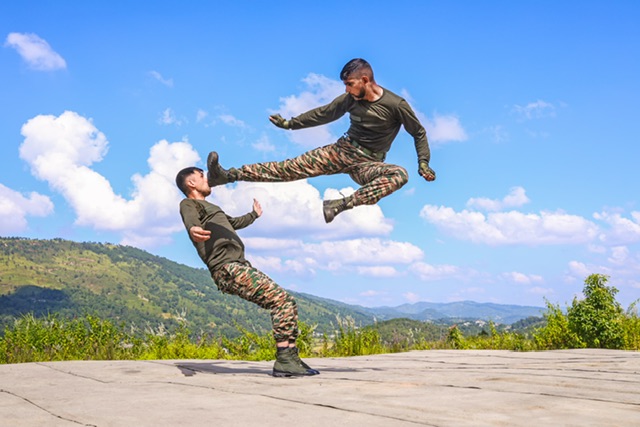India successfully concluded the joint bilateral military training exercise, Harimau Shakti, with the Malaysian army. The drill is designed to enhance the capability of troops of both countries in the tough, rainy and treacherous jungle terrain, by sharing tactics, combat expertise and technologies with each other.
Table of Contents:
- History of India-Malaya Relationship
- Exercise Harimau Shakti
- Legacy of training
- Significance of exercise
- Conclusion.
History of India-Malaya Relationship
Historically, India and Malaysia have deep rooted commonalties in their struggle for freedom. Most of the members of the Rani of Jhansi Regiment were teenage women volunteers of Indian descent from Malayan rubber estates. Prominent among them was Janaki Thevar who bravely led the Rani of Jhansi Regiment during the 1945 Manipur war. Indian National Army (INA) which included women contingent was one of the primary reasons which contributed immensely towards Indian Independence. After the 1945 Manipur War most of the women soldiers from this regiment along with Janaki Thevar went back to Malaysia. They also participated in independence movement of Malaysia. Their contribution in successful Malaysian Independence lead to development of quick diplomatic relations with the Federation of Malaysia. Relations between India-Malaysia have strengthened over the past decades since independence.
However, India’s defence relations with Malaysia have gained momentum during recent years. The MoU on Defence Cooperation signed in 1993 is the cornerstone of defence relations between the two countries. The Malaysian Defence Minister visited India in June 2006 and April 2017. Our Raksha Mantri visited Malaysia in January 2008 and again in November 2015.
Exercise Harimau Shakti 2023
The combined bilateral training exercise “Harimau Shakti 2023” between the Indian and Malaysian Armies began in Umroi Cantonment, India. This drill included roughly 120 individuals from both sides. It was aimed at enhancing military capability for the conduct of Multi Domain Operations in a sub-conventional scenario.
- Both contingents created a Joint Command Post, integrated surveillance grid and a Joint Surveillance Centre during the exercise.
- Both sides practised using joint forces in the jungle/semi-urban/urban situations.
- Drills for intelligence gathering, collation, and dissemination were also performed. Drones/UAVs and helicopters were used throughout the exercise.
- Both teams went through casualty management and evacuation drills.
- At the Battalion level, both contingents discussed logistical management and practiced survival training.
History:
Exercise Harimau Shakti, is an annual drill that began between the two countries in 2012. The first one was held in Pulai, Kluang, Malaysia. The exercise is to enhance interoperability and cooperation between the two armies, particularly in jungle warfare and counter-insurgency operations.
In 2018 this exercise was held in the dense forests of Sengai Perdik, Hulu Langat, Malaysia. It was aimed at “bolstering cooperation and coordination” between the armed forces of the two countries. The two contingents shared their expertise in the conduct of counterinsurgency operations in jungle terrain. Indian contingent was represented by the oldest infantry battalion 4 grenadier who have rich operational experience in conventional as well as counter-insurgency warfare. The Malaysian contingent was represented by soldiers from 1 Royal Ranjer Regiment and the Royal Malay Regiment, known for their experience in Jungle Warfare. The exercise involved a cross-training phase followed by a field-training phase of seven days in the jungles of Hulu Langat, which saw the two contingents jointly plan and execute a series of training activities.
Harimau Shakti 2022 commenced on November 28, 2022, at Pulai, Kluang, Malaysia and concluded on December 12, 2022. The Garhwal Rifles Regiment of the Indian Army and the Royal Malay Regiment of the Malaysian Army participated in the exercise of 2022. The exercise involved a Command Planning Exercise (CPX) at the Battalion level and a Company Field Training Exercise (FTX) on sub-conventional operations in jungle terrain. It also included the establishment of a joint command post and joint surveillance centre sharing expertise in employment of aerial assets, technical demonstrations, casualty management, casualty evacuation and planning logistics at the Battalion level. Joint field training exercises, joint combat discussions and joint demonstrations culminated post validation exercises, where special emphasis was placed upon enhancing tactical skills enhancing inter-operability between the forces and to promote Army to Army relations.
Significance of Military Exercise Between India & Malaysia
This joint military exercise between the Indian and Malaysian Armies has the primary aim of enhancing the capability of the armies in various operations in jungle terrain. By sharing gained experiences and defence cooperation these exercises train the soldiers to fight insurgencies, cartels and terror outfits in dense Jungle terrain, which both countries suffer. Along with the enhancement of the tactical skills of the troops and army-to-army relations, this drill also helps in the betterment of bilateral and economic relations with Malaysia. From a broader geopolitical perspective, this also reaffirms India’s bilateral relationship with Malaysia. This also gives a major push to India’s Act East policy with the ASEAN countries.
India has a significant influence in the geopolitical arena and tactical jungle-warfare capabilities. It is obligatory upon powerful nation like India to support friendly countries to develop military capabilities and tactics to strengthen their self-defence. Countries of the southeast region are inclined towards India’s because of her benign policies and unconditional assistance to neighbouring countries during crisis.

